We offer unique cultural tours in Mexico with a strong focus on the regional gastronomy . We design the itineraries to provide a farm to fork approach - with visits to villages, farms, plantations, markets, and restaurants of local renown. Our cuisine tours are designed with the "foodie" in mind and also include education on the ecosystems, agriculture, archaeology, colonial history, and visits with the living Maya and rural folk who for centuries have adapted to life in their various environments.
See below for our Yucatan Food Tour and our A Taste of Central Mexico tour. For those wanting a more intense culinary focus, we can customize the daily activities and itinerary. We can adjust the time sightseeing to allow for more cooking classes and gastronomy activities. We can also add more days along the way for relaxation and/or more explorations of the region.

Yucatan Food Tour
9 days itinerary starting and ending in Cancun
DAY 1:
Arrival into Cancun, Ouintana Roo, Mexico. Transfer and overnight at the Marriott Courtyard which is less than 10 minutes away.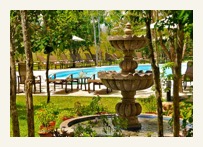
DAY 2: (B, L, D)
At breakfast, we have introductions and orientation before departing. We then drive into the interior of the Yucatan Peninsula to start at the beginning, with an introduction to the forest ecosystems of the region and how the Maya adapted to the environment. We travel in time - from the touring ruins of the ancient Mayan city of Coba to visiting a living Mayan community - this tour takes you though 1,500 years of Mayan history.
First is a short stop at the Punta Laguna Nature Reserve. Here we can experience the dense forest, view the beautiful lakes and hopefully see some spider of howler monkeys among the wildlife. While there, we visit in a small Mayan Village to learn how the rural Maya utilize the forests resources. We can also try some fresh juice from a variety of tropical fruits.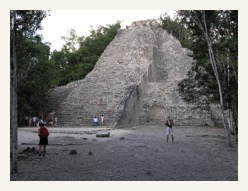
Next is a walking and bicycling tour of the immense Maya Classic Period archaeological site of Coba. Coba is one of the oldest and most important Mayan sites in the region, surrounded by jungle, it is complete with stelae, sacbes, ballcourts, observatory, and the tallest known pyramid in the Yucatan, Nohoch Muul - from the top you can enjoy a wonderful 360 degree view of the amazing subtropical jungle as far as the eye can see. You can learn how this now wild landscape supported over 40,000 people. As the Yucatan Peninsula lacks much in the way surface water, Coba was built around five shallow lakes and became an important center for corn and vegetable crops. Bikes rental at the site are optional.
Enjoy a delicious lunch Maya style in a beautiful restaurant with an amazing view over the lagoon of Coba. At the buffet you can choose from the salad bar, fish and between Maya specialities like Cochinita Pibil or Pollo Pibil, accompanied by rice or tortillas.
After lunch nearby, we drive to historic Valladolid for two overnights at the El Meson Marques Hotel or the Ecotel Quinta Regia.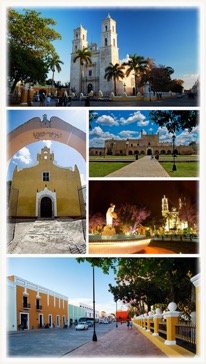
After a siesta, is an evening visit to the ruins of the Convent San Bernardino and then dinner at the Taverna de los Frailes, a restaurant renown for its gourmet fusion with traditonal regional ingredients and flavors.
DAY 3: (B, L)
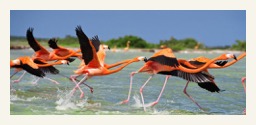 Early morning departure to the Caribbean coast to the seaside village of Rio Largartos, famous for its colonies of flamingos. We then have a boat ride through the mangrove estuaries to view the flamingos and abundant wildlife species. While out, a mud bath and a swim in a freshwater spring or at a beach is optional. Later we have a freshly-caught seafood lunch at the Macumba or La Torreja local restaurants.
Early morning departure to the Caribbean coast to the seaside village of Rio Largartos, famous for its colonies of flamingos. We then have a boat ride through the mangrove estuaries to view the flamingos and abundant wildlife species. While out, a mud bath and a swim in a freshwater spring or at a beach is optional. Later we have a freshly-caught seafood lunch at the Macumba or La Torreja local restaurants. 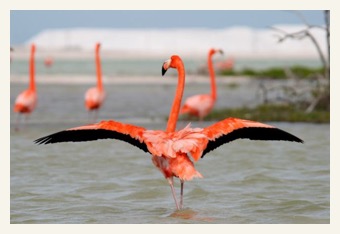
After lunch on the return to Valladolid is tour of the recently partialy-restored site of Ek Balám. Its iconography is some of the most impressive in all the Mundo Maya. Ek Balám has one of the longest records of occupation in northern Yucatán, from about 300 BC until the Spanish Conquest. Recent excavations have uncovered some of the finest of all known Mayan sculptures.
For those would would like, you can also independently visit the Xcanche Cenote about 1.5km from the ruins (optional, with about $5 entrance fee). There are usually kids with bicycle taxis or you may walk.
After the tour, we can stop on the way in Temozón, a town famous for its smoked meats. Our "last" stop is at an agave farm and distillery. Here we can learn how three achololic drinks (pulque, mezcal and tequilla) are made from this succulent plant (not a cactus). The Mayapan Distillery's liquor is a 100% Blue Agava distilled beverage - but it can not be called legally tequilla, since it is not made in the state of Jallisco. (Just like California sparking whiite wine can not be legally called Champagne since it was not made in the provence of Champagne in France.)
A great option in Valladolid for dinner (meal not included) is the El Meson De Marques Hotel and Restaurant. located on the main plaza.
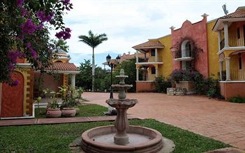
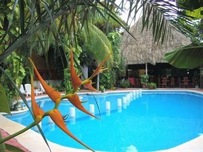

DAY 4: (B, L)
After breakfast, upon departing Valladolid we may take a quick stop to photograph the two scenic underground cenotes of Xkeken and Samula at Dzitnup.
In the morning we depart for a tour of the famous archaeological site of Chichén Itzá to explore this incredible "Mexicanized/Maya" site. In 2007, the El Castillo (KuKulkan Pyramid) was named one of the New Seven Wonders of the World.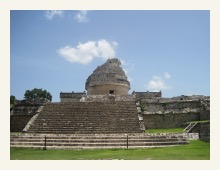
For lunch and to relax, we go to the swimmable Yokdzonot Cenote (www.yucatanmayanretreat.webs.com). About 10 minutes from the ruins, the cenote and restaurant is operated by local women starting their own ecopark. It is a good place to learn about local medicinal plants and the authentic Yucatecan meals include handmade tortillas. The cenote is far less crowded than the Ik Kil Cenote which is close to the ruins.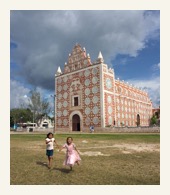
Afterwards, we then drive to the Spanish Colonial city of Izamal. In route we will have a quick stop at the village of Uayma to see and learn about its colorful church. At Itzamal, we will explore the Franciscan monastery of San Antonio de Padua, whose construction started in 1533 and completed in 1561, making it one of the first monasteries in the New World. It is site of the largest atrium in the Americas and second only to the Vatican. Izamal is a jewel of a colonial city, with many the historic buildings painted yellow. Cobblestone streets and colonial lampposts complete the scenery. Clean, peaceful and quaint, this is a great town to stroll through. There are Mayan pyramids, colonial-style buildings, parks and plazas, horses and buggies, and lots of people-watching. We can also see the massive Kinich Kak Mo pyramid.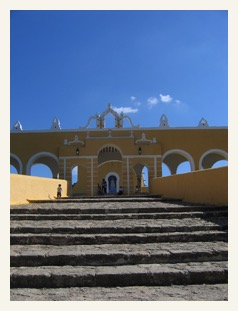
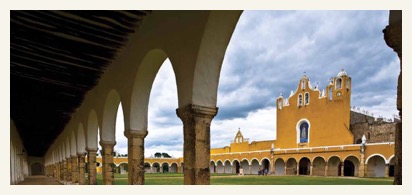 We can then have an early dinner at the popular Kinich El Sabor Restaurant, famous for its authentic Yucatec cuisine. The dining room is open and airy, but the most popular seating is outside under the thatched-roof palapa. Surrounded by tropical foliage, women shape corn tortillas by hand and then cook them on a metal griddle over a wood-burning fire. The hot tortillas are then served with regional specialties like poc-chuc—sliced pork marinated in orange juice and topped with fresh salsa.
We can then have an early dinner at the popular Kinich El Sabor Restaurant, famous for its authentic Yucatec cuisine. The dining room is open and airy, but the most popular seating is outside under the thatched-roof palapa. Surrounded by tropical foliage, women shape corn tortillas by hand and then cook them on a metal griddle over a wood-burning fire. The hot tortillas are then served with regional specialties like poc-chuc—sliced pork marinated in orange juice and topped with fresh salsa.
We then continue on to Mérida for three overnights at the colonial-style Casa del Balam or Mision Del Fray, located downtown near the Main Plaza.
DAY 5: (B, L)
In the morning we have a guided tour the Main Plaza or zócalo, with such buildings as the Cathedral (started in 1561) and the Governor's Palace for historical perspective seen highlighted in its dramatic murals and paintings. This vibrant Mexican city still retains much of its colonial charm. At one time, it was one of the richest cities in the world. It is often called the "white city" for its architecture and native dress,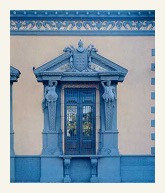 but as you will see, it is also a very "colorful" city; full of new sights, sounds and smells. Founded by the Spanish in 1542, Mérida was built over the ancient Maya city of Tiho. It was named Mérida because the Mayan city reminded the Conquistadors of the Roman ruins in Mérida, Spain. Mérida has one of the largest historic districts in the Americas (surpassed only by Mexico City and Havana). During evening strolls down peaceful streets, you can admire some of the beautiful old houses and landmarks found at every turn in downtown Merida. The historical center of Mérida is currently undergoing a renaissance as more people are moving into the old buildings and reviving their former glory. Many are now winter homes owned by foreigners as the city's popularity for a great place to live has grown internationally. Because of its tranquility and cleanliness, Mérida has also become a popular place for families from other Mexican states. Many people have moved here from Mexico City, where crime, pollution and overcrowding are evergrowing problems. Crime is not tolerated in Mérida, and it has the distinction of the city with the lowest crime rate per capita in Mexico.
but as you will see, it is also a very "colorful" city; full of new sights, sounds and smells. Founded by the Spanish in 1542, Mérida was built over the ancient Maya city of Tiho. It was named Mérida because the Mayan city reminded the Conquistadors of the Roman ruins in Mérida, Spain. Mérida has one of the largest historic districts in the Americas (surpassed only by Mexico City and Havana). During evening strolls down peaceful streets, you can admire some of the beautiful old houses and landmarks found at every turn in downtown Merida. The historical center of Mérida is currently undergoing a renaissance as more people are moving into the old buildings and reviving their former glory. Many are now winter homes owned by foreigners as the city's popularity for a great place to live has grown internationally. Because of its tranquility and cleanliness, Mérida has also become a popular place for families from other Mexican states. Many people have moved here from Mexico City, where crime, pollution and overcrowding are evergrowing problems. Crime is not tolerated in Mérida, and it has the distinction of the city with the lowest crime rate per capita in Mexico. 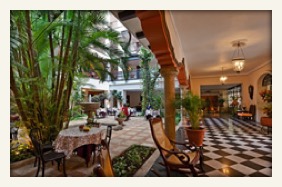
Merida also boasts a large number of restaurants for all types of cuisine, from the most basic and inexpensive to the most sophisticated fine dining. Traditional Yucatecan cookery derived from the mixing of Spanish and Maya cultures. It is the combination of recipes and ingredients from those two culinary traditions that has resulted in the characteristic flavors of Yucatecan cuisine. It also includes influences from Caribbean, European, and Middle Eastern cultures. Yucatecan food is renowned throughout Mexico for its strong condiments and the predominant use of corn. For instance, dishes like lime soup, papadzules and Motul-style eggs are all made with fried corn tortillas, and panuchos and dzotolbichay are made with corn dough. Another common ingredient in some of the most exquisite traditional Yucatecan dishes is turkey. And not to be ignored are wonderful Yucatecan desserts, most of which are prepared with locally grown fresh fruit.
We then visit the Merida's main market to learn about local produce and to shop for our lunch foods. This historic central market is about 3 blocks from the Zócalo and is one of the largest remaining in Mexico. (Here is a nice video regarding food shopping in the market.) Afterwards we have a cooking class, including making fresh torillas, and then enjoy our work.
In the late afternoon is a visit the new and expansive Gran Museo Del Mundo Maya. (www.granmuseodelmundomaya.com). There is an onsite restaurant for those who want to rest or have an early dinner. The expansive museum has a collection of more than 500 pieces, including textiles, religious objects, and items reflecting the current lives of the Mayas. They have engravings, books, and historical documents, artistic and religious works from the colonial historic era in addition to artifacts from the pre-Hispanic era including stelas, stone sculptures, ceramics and offerings. The exhibit rooms move from the present into the past through four distinct sections: The Mayab, Nature and Culture; Mayas of Today; Mayas of Yesterday; and Ancestral Mayas.

Nearby the hotel and main plaza are a variety of nice local restaurants to try, such as the locally popular La Chaya Maya for authentic traditional, or the Rosas & Xocolate for upscale.
Note: Saturday and Sunday nights are part of En El Corazón de Mérida (In the Heart of Merida), when Calles 60 & 62 are closed off to traffic around the Main Plaza from 8 pm to 2 am and the restaurants and bars put their tables and chairs in the street. This is literally an open-air fiesta as there are bands on every block and other shows. Temporary stages host everything from rock to salsa to trova singers. On Saturday nights you may also go to the outdoor Fiesta Mexicana at the beginning of the Paseo Montejo at Calle 47. Here you will find vendors, food booths and Mexican folkloric entertainment. (B/L)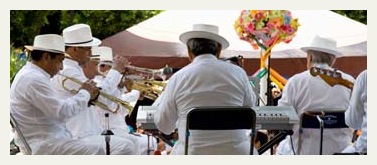
DAY 6: (B, L)
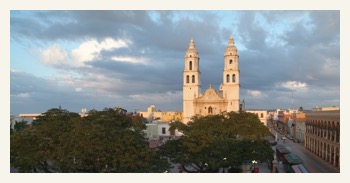 After breakfast, we depart to the coast for a day tour of the historic city of Campeche, in the State of Campeche. The capital, San Francisco de Campeche, during the times of the Viceroyalty was the largest port on the Yucatan Peninsula and is one of the first Spanish Colonial cites in Mexico. The export of woods was concentrated here, especially logwood or Campeche, a natural dye which was greatly demanded in Europe and America until the emergence of industrial dyes. The beautiful old city is fortified and surrounded by 18th-century walls. The city, once the site of the pre-Colombian town called Kimpech (whose remains are still observable), was founded in 1540 by the son of the Spanish conquistador Francisco de Montejo. It was sacked frequently by English buccaneers, and from 1862 to 1864, French forces blockaded the city.
After breakfast, we depart to the coast for a day tour of the historic city of Campeche, in the State of Campeche. The capital, San Francisco de Campeche, during the times of the Viceroyalty was the largest port on the Yucatan Peninsula and is one of the first Spanish Colonial cites in Mexico. The export of woods was concentrated here, especially logwood or Campeche, a natural dye which was greatly demanded in Europe and America until the emergence of industrial dyes. The beautiful old city is fortified and surrounded by 18th-century walls. The city, once the site of the pre-Colombian town called Kimpech (whose remains are still observable), was founded in 1540 by the son of the Spanish conquistador Francisco de Montejo. It was sacked frequently by English buccaneers, and from 1862 to 1864, French forces blockaded the city. 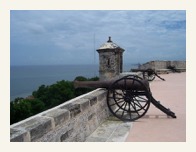 Visits to the imposing Fort San Miguel and it's impressive Regional Anthropology Museum teach of the area's archaeology and history. Wealthy merchants and traders built stunningly beautiful houses and haciendas here. Today hundreds of these have been carefully restored to their former glory and repainted with the original soft pastel orginally used in the construction. In 1999 UNESCO declared Campeche a World Heritage Site. Campeche's colorful historical center is one of the most striking in Mexico and is the most walking-friendly of any capital city in Mexico. No buses are allowed inside the old walls of the historic area. History has divided Campeche City into three zones: The Center, formed by the old walled city which was
Visits to the imposing Fort San Miguel and it's impressive Regional Anthropology Museum teach of the area's archaeology and history. Wealthy merchants and traders built stunningly beautiful houses and haciendas here. Today hundreds of these have been carefully restored to their former glory and repainted with the original soft pastel orginally used in the construction. In 1999 UNESCO declared Campeche a World Heritage Site. Campeche's colorful historical center is one of the most striking in Mexico and is the most walking-friendly of any capital city in Mexico. No buses are allowed inside the old walls of the historic area. History has divided Campeche City into three zones: The Center, formed by the old walled city which was 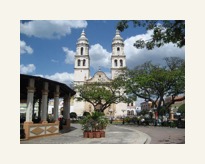 inhabited by the Spaniards during the Colony San Francisco, located to the north of the wall, where the Mayan population was concentrated; and San Roman to the south, where the Mexican natives established themselves along with the mulattos brought from the Islands of the Caribbean, mainly from Cuba. Campeche today has many brightly colored buildings reflective of Caribbean tastes.
inhabited by the Spaniards during the Colony San Francisco, located to the north of the wall, where the Mayan population was concentrated; and San Roman to the south, where the Mexican natives established themselves along with the mulattos brought from the Islands of the Caribbean, mainly from Cuba. Campeche today has many brightly colored buildings reflective of Caribbean tastes.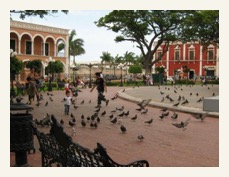
As might be expected in a coastal town, Campeche has an abundance of fresh seafood prepared in every conceivable manner including some flavored with tasty Caribbean spices. We have lunch at one of the many good seafood restaurants. Campeche is famous for its cuisine, particularly seafood and restaurants offer unique dishes such as: jamon claveteado (clove ham),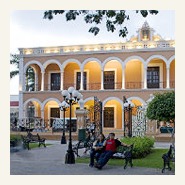 pan de cazon (fried tortilla with shred dogfish, tomato sauce and beans), queso relleno (pepper stuffed Gouda cheese), pampano en salsa verde (pompano in green sauce) and of course, seafood cocktails, pickled fish, shrimps in many styles and fish croquettes.
pan de cazon (fried tortilla with shred dogfish, tomato sauce and beans), queso relleno (pepper stuffed Gouda cheese), pampano en salsa verde (pompano in green sauce) and of course, seafood cocktails, pickled fish, shrimps in many styles and fish croquettes.
On the afternoon drive back to Uxmal. We may stop in the village of Kuck Holocj near Becal, to visit a family for a demonstration of weaving high-quality hats made from the jippi plant. These "panama" hats are woven in caves to create an environment that is humid enough for the plant fibers to remain malleable. (B/L)
DAY 7: (B, L)
In the morning we depart south to visit the grandiose archaeology site of Uxmal.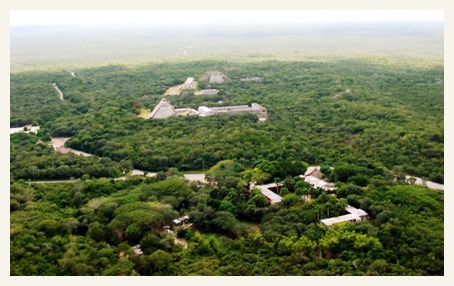
Many consider Uxmal the most ornate and complex Mayan city yet found, you will quickly see why it is so famous as a destination. The scale of construction and the delicate carved facades are truly remarkable for any culture. Standing over 100 feet up on the Temple of the Magician, one has an excellent viewpoint of the entire site and surrounding Puuc hills. Recent excavations and restorations has brought even more of the site's grandiose structures into the light. Even before the restoration work, Uxmal was in better condition than many other Maya sites thanks to being so well constructed. Much was built with cut stones, not relying on plaster to hold the buildings together. The intricate Puuc style of Maya architecture predominates. Thanks to its good state of preservation, it is one of the few Maya cities where the visitor can get a good idea of how the entire ceremonial center looked in ancient times.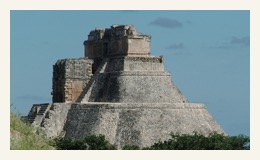
After the guided tour, we have lunch in the town of Ticul at the famous Loa Almendros Restaurant, famous for its poc-chuc, a roasted pork served with chiltomate, seasoned onions, beans and handmade tortillas. The Restaurant Campestre Los Almendros is a symbol of quality and tradition of over 40 years providing Yucatecan dishes such as Stuffed Black, Ticuleño Chicken, Stuffed White Sausage Asada, Panuchos, Eggs Ticuleños. It should be noted that all meals are prepared with ingredients, utensils and Mayan recipes.
While out touring the area, we will also visit the EcoMuseo del Cocao and its cocoa plantation for education and tasting.
On the return to Merida, we can visit the historic Hacienda Yaxcopoil to learn about sisal and henequen plantations during the colonial period.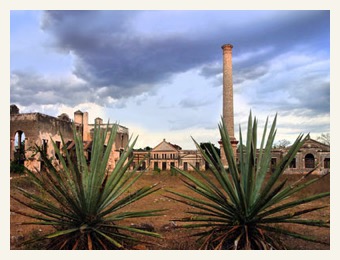 The hacienda is left much as it was in historic times, with furniture and machinery still in place. It was named for the nearby Mayan ruins and at one time covered about 22,000 acres of land, operating first as a cattle ranch and later as a henequen plantation. Once of of the most important haciendas in Yucatan, it has been preserved but not renovated, and now operates as a museum, and location for filming.
The hacienda is left much as it was in historic times, with furniture and machinery still in place. It was named for the nearby Mayan ruins and at one time covered about 22,000 acres of land, operating first as a cattle ranch and later as a henequen plantation. Once of of the most important haciendas in Yucatan, it has been preserved but not renovated, and now operates as a museum, and location for filming.
DAY 8: (B, L)
In the morning, we depart to the Caribbean coast's Maya Riveria. On the way we can have lunch at the Hacienda Chichen Itza, which offers top quality cuisine and diverse culinary choices, organic gourmet cuisine, delicious flavors and zesty aromas. With his exceptional Maya Cuisine background and Gourmet Fusion Menu Selections, Executive Chef Josue Cime has caught the attention of many professional culinary critics for his artistic and exquisite cooking achievements. His traditional Maya culinary heritage and innovative Organic Fusion Cuisine, together with his passion for fresh healthy ingredients and product quality, ensures you a delightful food experience. Hacienda Chichen has won top culinary ratings from respected food critics and International culinary magazines, who consider this green hacienda among Mexico's finest gourmet culinary destinations.
We then continue on to your seaside accommodation at in Puerto Moreles. Still retaining its "Mexican" roots, the town is close to Cancun for transfers out.
DAY 9: (B)
Transfer to Cancun airport for flights home.
Note: Extra nights and tours can be added desired locations.
SERVICES
- all airport transfers and ground transportation throughout with private guide
- all lodging
- guided tours as listed including entrance fees
- meals as listed with (B, L, D)


A Taste of Mexico Adventure
9 days itinerary starting and ending in Mexico City
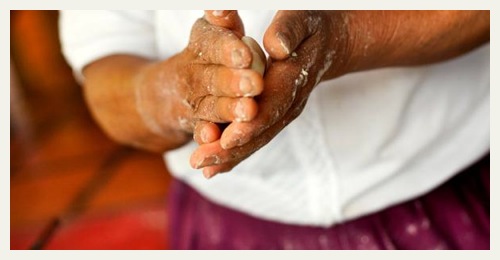 Indulge in the regional cuisines of Mexico, explore breathtaking colonial Puebla and Oaxaca, try out your salsa skills on the dance floor, sink into the pace of life on the Pacific Coast. Somehow, Mexico has become synonymous with boring resorts and crowded beaches. That’s not the Mexico we know. Come and experience ours on this 9-day journey into the country’s colonial past. Beginning in Mexico City, you’ll move on to Puebla and indulge in their famous spicy and chocolate-y mole sauce then explore Oaxaca’s pre-Spanish ruins and Baroque churches. Enjoy the beaches of the Pacific Coast – let this destination get under your skin.
Indulge in the regional cuisines of Mexico, explore breathtaking colonial Puebla and Oaxaca, try out your salsa skills on the dance floor, sink into the pace of life on the Pacific Coast. Somehow, Mexico has become synonymous with boring resorts and crowded beaches. That’s not the Mexico we know. Come and experience ours on this 9-day journey into the country’s colonial past. Beginning in Mexico City, you’ll move on to Puebla and indulge in their famous spicy and chocolate-y mole sauce then explore Oaxaca’s pre-Spanish ruins and Baroque churches. Enjoy the beaches of the Pacific Coast – let this destination get under your skin.
What's Included: (2015 Costs start at $1249 per person in double occupancy)
Puebla orientation walk. Oaxaca orientation walk. Cooking class with dinner. Mezcal factory tour. Seafood dinner (Puerto Escondido). Market visit.
Internal flights.
All transport between destinations and to/from included activities.
3 dinners. (Allow USD240-320 for meals not included.)
Hotels (8 nts, basic tourist class)
Public bus, plane
Professional guide throughout.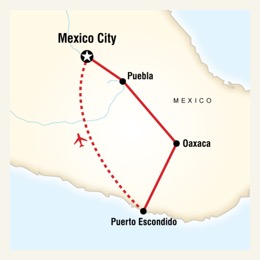
DAY 1, MEXICO CITY
Arrive in Mexico City at any time. There are no planned activities during the day, so check into the hotel and enjoy this charming city. Please try to arrive before 6pm for an important group meeting where you can meet the Chief Experience Officer (CEO) and the other group members. Following the welcome meeting, head out for your first of many meals with this group as you wine and dine your way through Central Mexico.
Explore the world's largest metropolitan area or take an optional day trip to the famous archaeological site of Teotihuacan. The former Aztec Capital (you can still see some of the ruins of the great Tenochtitlán in the centre of the city, or take a subway ride through one of the temples) was destroyed in the struggle with Cortez and those who followed him. Today it is the world’s fastest growing urban centre, offering a great variety of impressive museums, galleries and range of architecture, perhaps unequalled anywhere else in the Americas. Mexico City or D.F., as the locals refer to it, also has a variety of food to match its impressive visual style. If you prefer to get outside the city, the pyramids of Teotihuacán and the canals and gardens of Xochimilco are two good places to start.
A word of caution: Mexico City may be slightly overwhelming at first. The world’s most populous centre is a crowded, smoggy, urban place where the altitude combined with atmospheric conditions may cause irritation of eyes, nose and throat. Also be aware that the heat may affect you upon arrival, with a general sense of lethargy and/or loss of appetite. This is no cause for alarm; it is simply a reaction to the heat. Be sure to drink plenty of water (cold bottled water is available everywhere) and do not attempt too much in any given day.
Mexico is the third largest country in Latin America and the most populous Spanish speaking country in the world. Its geography ranges from swamp to desert, from tropical lowland jungle to high alpine vegetation and from thin arid soils to others so rich that they grow three crops a year.
Days 2-3, Puebla (1D)
Head to Puebla, famous for its hand-painted tiles, unique handicrafts, mouth-watering Mole Poblano (a mouth-watering spicy sauce made with cocoa and infinite varieties of chillies) and rich colonial history. Take part in a mole-making class to learn the secrets of this famous sauce.
Puebla has managed to incorporate its colourful colonial past with a growing and progressive modern city centre. There are enough churches and well-maintained, colonial buildings to satisfy the most ardent lover of architecture. The markets, of course, are also present for buying, browsing or photographing.
While you're here, you will enjoy an included dinner at the Fonda de Santa Clara, a restaurant known for both its quality of food and selection of regional and seasonal specialties. Some of these specialties include the following:
"Chiles en nogada" - found late summer/early fall harvest season. Ground meat is seasoned and combined with raisins, pine nuts and local fruit before being stuffed tinto roasted poblano chiles. These stuffed chiles are then dipped in batter and fried before being topped off with a creamy sauce made partially of walnuts and then topped with pomegranates.
"Molotes" - Chorizo (spicy sausage), squash blossoms with cheese or herbed sliced new potatoes are tucked into a circle of thin corn dough before all is sealed and fried in oil until crisp.
"Tinga" - Shredded pork is is added to a clay pot filled with tomatoes, garlic, onions and chipotle chiles and simmered until the flavours combine. This mixture is served on tostadas, or hardshell tortillas, with lettuce and avocado.
Days 4-5, Oaxaca (1D)
The colourful and lively markets and the impressive Zapotec ruins of Monte Alban are just two of many reasons to visit wonderful Oaxaca. The conqueror of Mexico, Hernán Cortez, chose the Valley of Oaxaca as his personal domain in the Americas and many visitors have followed in his footsteps. Surrounded by the Sierra Madre del Sur and Sierra Madre de Oaxaca mountain ranges, Oaxaca is a lovely colonial city, which has maintained not only the physical structures, but also the serenity of an era gone by.
Explore the colourful markets and enjoy an included cooking class to get the most out of the Mexican cuisine experience! We also include a short visit to a mezcal factory that produces the fiery "other tequila" which is this region's specialty.
Monte Albán, a spectacular grouping of pre-Hispanic (Zapotec) mountain top temples, is just a short bus ride away, as is the Valley of Mitla with its colourful ruins and hand-loomed carpets. Stepping from the cultural to the culinary, Oaxaca is also a great area for trying out new tastes and textures. From the sublime to the exotic, the restaurants and markets around town will challenge you to one adventure after another. After all, this is the home of Mezcal (look for the unfortunate worm at the bottom), Oaxacan chocolate, cheese, and yes, even salted grasshoppers, if you are so inclined.
Days 6-7, Puerto Escondido (1D)
Drive to the coast and enjoy time in the beach paradise on the Pacific. Opt to lounge on the beach, try surfing, diving or take an eco tour to spot dolphins, sailfish or sea turtles. Visit the local market for a taste of how the locals shop and enjoy a seafood dinner in town.
Day 8, Mexico City
Catch a flight back to the largest city in the world! This fascinating multi-layered megalopolis is home to an endless list of cultural wonders, the best anthropology museum for Mexican archaeology, the largest plaza (the zocalo), the Zona Rosa, many Aztec historic sites, and a vibrant street life at all hours. Travel back to this massive city and hit a few of the attractions and restaurants you weren't able to visit on your first time through.
Day 9, Mexico City
Depart at any time.


YUCATECAN CUISINE (mostly from Yucatan Today)
The culinary delights of a typical Yucatecan kitchen come from a mouth-watering mixture of European and Mexican flavors. A bit of history will explain this strong European influence. Once upon a time the Yucatecan peninsula was considered to be too far away and too difficult to reach from the rest of Mexico. Mountainous terrain and very poor roads kept the peninsula isolated. Having ports with commercial and cultural contacts with Europe (especially France), New Orleans, and Cuba, the Yucatecans were easily influenced by many aspects of these countries, such as dress, architecture and cooking, which explains why there is a lot of European flair in its cuisine.
Pollo Pibil
Chicken marinated in achiote (annatto), sour orange juice, peppercorns, garlic, cumin, salt, and then wrapped in banana leaves and baked. This dish can also be made with pork (cochinita pibil). A dish you should definitely try for lunch or dinner. Not spicy.
Salbutes
Soft, cooked tortillas with lettuce, tomato, shredded turkey or chicken, onion, avocado on top.
Panuchos
Feature fried tortillas filled with black beans, and topped with turkey or chicken, lettuce, avocado and pickled onions.
Lime Soup
A delicious soup made with shredded chicken, bits of fried tortilla, and lime juice. Exquisite! And very good for you if you aren't feeling well.
Poc Chuc
Tender slices of pork marinated in sour orange juice, grilled, and served with a tangy sauce and pickled onions. Some restaurants offer a chicken version.
Papadzules
Chopped hard boiled egg rolled up in tortilla and covered with pumpkin seed sauce.
Frijol con Puerco
The Yucatecan version of pork and beans. Chunks of pork cooked with black beans, served with rice, and garnished with radish, cilantro and onion. A regular Monday dish in most Yucatecan homes.
Motul-Style Eggs A scrumptious breakfast of tortilla, covered with refried beans and a fried egg and then smothered with tomato sauce, peas, chopped ham and shredded cheese. Usually served with some fried banana slices.
Pavo en Relleno Negro (also known locally as Chilmole)
Turkey meat stew cooked with a black paste made from roasted chiles, a local version of the mole de guajalote found throughout Mexico. The meat soaked in the black soup is also served in tacos, sandwiches and even in panuchos or salbutes.
Bul keken, (Mayan for "beans and pork")
A traditional black bean and pork soup. The soup is served in the home on Mondays in most Yucatán towns. The soup is usually served with chopped onions, radishes, chilies, and tortillas.
Brazo de reina, (Spanish for "The Queen's Arm")
A traditional tamal dish. A long, flat tamal is topped with ground pumpkin seeds and rolled up like a roll cake. The long roll is then cut into slices. The slices are topped with a tomato sauce and a pumpkin seed garnish.
Spices and chiles
Achiote is the most popular spice in the area. It is derived from the hard annatto seed found in the region. The whole seed is ground together with other spices and formed into a reddish seasoning paste, called recado rojo. The other ingredients in the paste include cinnamon, allspice berries, cloves, Mexican oregano, cumin seed, sea salt, mild black peppercorns, apple cider vinegar, and garlic. The most popular Mexican hot sauce, El Yucateco hot sauce, is made in Mérida, Yucatán. Hot sauce in Mérida is usually made from the indigenous chiles in the area which include: Chile Xcatik, Chile Seco de Yucatán, and Chile Habenero.
Michelada
Okay, this isn't food...it's a beer. You'll see it on the menu and wonder what it is. Michelada roughly translates as "my cold beer". The spicy concoction is a beer with lime and peppery seasoning. The ingredients are lime, coarse salt, Worcestershire sauce, soy sauce, Tabasco sauce, black pepper, Maggi seasoning, and beer, preferably a dark Mexican beer like Negra Modelo. Another option is a CHELADA, which is a Michelada without the Tabasco, soy, pepper and other seasonings. It's just beer, lime, and salt.
MEXICAN CUISINE (common in the Yucatan)
Chiles Rellenos (stuffed chilis)
Poblano chilis are stuffed with either cheese or ground beef and pork, raisins, capers and olives, then coated in a batter, fried, and served with a tomato sauce on top.
Chiles en Nogada (gourmet stuffed chiles)
This is Mexican cuisine’s gourmet haute-cuisine dish, a fancy upscale cousin to Chiles Rellenos. Poblano chiles are stuffed with ground beef and pork, raisins, onion, garlic, peaches, apples, pear and crystallized orange and covered with a walnut sauce and pomegranate seeds.
Frijoles Charros
Often translated as cowboy bean soup, this is a red bean soup with diced ham, sausage, tomatoes and onion. Served separately are chopped onions, lime wedges and cilantro that you can add as you please.
Queso fundido
Often translated as cheese fondue or melted cheese, this cheese dish is not as soupy as traditional fondue. A stringy Oaxaca cheese is melted in a ceramic bowl and served with tortillas. To eat it, rip the tortilla in ½ or ¼, take your fork, twirl some cheese around it then place it in the tortilla. Queso fundido adds-ons include mushrooms, poblano chiles (spicy-ish), chorizo sausage, cactus, or diced meat.
Mole Poblano
The sauce in this savory dish is made from 17 different ingredients that are ground up and blended. Ingredients include: mulato chiles, pasilla chiles, ancho chiles,, Mexican chocolate, peanuts, garlic, black pepper, cinnamon, raisins, cloves, peppercorns, almonds, anise seeds, coriander seeds, pumpkin seeds, and sesame seeds. The sauce is served over either chicken or pork and is wonderful. While not a spicy hot dish, spiciness depends on the chiles.
Guacamole
This traditional snack dish is one of Mexico’s claims to fame. Mix chunky avocado, chopped onion, cilantro, salt, some lime juice and possibly chopped tomato. Serve with tortilla chips. If you make it ahead of time, don’t put it in the fridge- that way it won’t turn dark.
Tamales
Yucatan has its tamales and the rest of Mexico has theirs. Mexican tamales have mole sauces or poblano chiles, can be sweet, and are mostly wrapped in cornhusks (instead of the Yucatecan banana leaves.)
Enchiladas
There are many versions of and ways to make enchiladas, but the basics are made with corn tortillas dipped in the chosen enchilada sauce (to soften), which can be mole, green tomato sauce, etc. then stuffed with chicken or meat, rolled up, placed in a casserole dish, then layered with sauce and cheese and cream and topped with chopped onions or crumbled white cheese.
Chilaquiles (Pronounced chee-lah-KEE-lehs)
This dish is popular at breakfast. Corn tortillas are cut in strips or triangles, fried in cooking oil, then topped with a red tomato or green tomato sauce then layered casserole style. Cream is drizzled on top. Shredded chicken can be added.
Empanadas
Handmade tortilla folded over cheese or chicken and topped with lettuce, tomato and cream
Quesadillas
Wheat-flour tortilla with ham and cheese, lettuce, tomato sauce and cream
Sopes
Tortillas cooked in traditional comal, topped with bean paste, cheese, lettuce, chicken, tomato and cream
Pollo a la plancha
Grilled Chicken breast topped with rice and bean paste, with salad
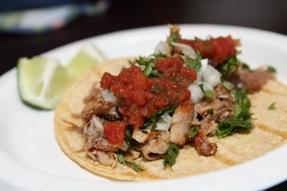
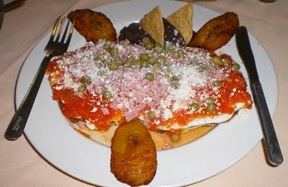
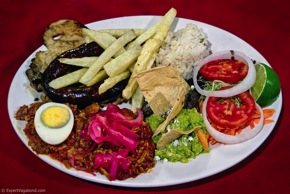
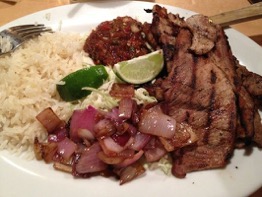

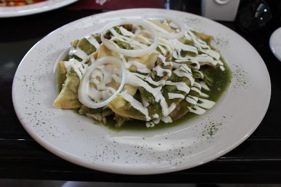
Return to the top of this webpage :)
See below for our Yucatan Food Tour and our A Taste of Central Mexico tour. For those wanting a more intense culinary focus, we can customize the daily activities and itinerary. We can adjust the time sightseeing to allow for more cooking classes and gastronomy activities. We can also add more days along the way for relaxation and/or more explorations of the region.
Yucatan Food Tour
9 days itinerary starting and ending in Cancun
DAY 1:
Arrival into Cancun, Ouintana Roo, Mexico. Transfer and overnight at the Marriott Courtyard which is less than 10 minutes away.

DAY 2: (B, L, D)
At breakfast, we have introductions and orientation before departing. We then drive into the interior of the Yucatan Peninsula to start at the beginning, with an introduction to the forest ecosystems of the region and how the Maya adapted to the environment. We travel in time - from the touring ruins of the ancient Mayan city of Coba to visiting a living Mayan community - this tour takes you though 1,500 years of Mayan history.
First is a short stop at the Punta Laguna Nature Reserve. Here we can experience the dense forest, view the beautiful lakes and hopefully see some spider of howler monkeys among the wildlife. While there, we visit in a small Mayan Village to learn how the rural Maya utilize the forests resources. We can also try some fresh juice from a variety of tropical fruits.

Next is a walking and bicycling tour of the immense Maya Classic Period archaeological site of Coba. Coba is one of the oldest and most important Mayan sites in the region, surrounded by jungle, it is complete with stelae, sacbes, ballcourts, observatory, and the tallest known pyramid in the Yucatan, Nohoch Muul - from the top you can enjoy a wonderful 360 degree view of the amazing subtropical jungle as far as the eye can see. You can learn how this now wild landscape supported over 40,000 people. As the Yucatan Peninsula lacks much in the way surface water, Coba was built around five shallow lakes and became an important center for corn and vegetable crops. Bikes rental at the site are optional.
Enjoy a delicious lunch Maya style in a beautiful restaurant with an amazing view over the lagoon of Coba. At the buffet you can choose from the salad bar, fish and between Maya specialities like Cochinita Pibil or Pollo Pibil, accompanied by rice or tortillas.
After lunch nearby, we drive to historic Valladolid for two overnights at the El Meson Marques Hotel or the Ecotel Quinta Regia.

After a siesta, is an evening visit to the ruins of the Convent San Bernardino and then dinner at the Taverna de los Frailes, a restaurant renown for its gourmet fusion with traditonal regional ingredients and flavors.
DAY 3: (B, L)


After lunch on the return to Valladolid is tour of the recently partialy-restored site of Ek Balám. Its iconography is some of the most impressive in all the Mundo Maya. Ek Balám has one of the longest records of occupation in northern Yucatán, from about 300 BC until the Spanish Conquest. Recent excavations have uncovered some of the finest of all known Mayan sculptures.
For those would would like, you can also independently visit the Xcanche Cenote about 1.5km from the ruins (optional, with about $5 entrance fee). There are usually kids with bicycle taxis or you may walk.
After the tour, we can stop on the way in Temozón, a town famous for its smoked meats. Our "last" stop is at an agave farm and distillery. Here we can learn how three achololic drinks (pulque, mezcal and tequilla) are made from this succulent plant (not a cactus). The Mayapan Distillery's liquor is a 100% Blue Agava distilled beverage - but it can not be called legally tequilla, since it is not made in the state of Jallisco. (Just like California sparking whiite wine can not be legally called Champagne since it was not made in the provence of Champagne in France.)
A great option in Valladolid for dinner (meal not included) is the El Meson De Marques Hotel and Restaurant. located on the main plaza.



DAY 4: (B, L)
After breakfast, upon departing Valladolid we may take a quick stop to photograph the two scenic underground cenotes of Xkeken and Samula at Dzitnup.
In the morning we depart for a tour of the famous archaeological site of Chichén Itzá to explore this incredible "Mexicanized/Maya" site. In 2007, the El Castillo (KuKulkan Pyramid) was named one of the New Seven Wonders of the World.

For lunch and to relax, we go to the swimmable Yokdzonot Cenote (www.yucatanmayanretreat.webs.com). About 10 minutes from the ruins, the cenote and restaurant is operated by local women starting their own ecopark. It is a good place to learn about local medicinal plants and the authentic Yucatecan meals include handmade tortillas. The cenote is far less crowded than the Ik Kil Cenote which is close to the ruins.

Afterwards, we then drive to the Spanish Colonial city of Izamal. In route we will have a quick stop at the village of Uayma to see and learn about its colorful church. At Itzamal, we will explore the Franciscan monastery of San Antonio de Padua, whose construction started in 1533 and completed in 1561, making it one of the first monasteries in the New World. It is site of the largest atrium in the Americas and second only to the Vatican. Izamal is a jewel of a colonial city, with many the historic buildings painted yellow. Cobblestone streets and colonial lampposts complete the scenery. Clean, peaceful and quaint, this is a great town to stroll through. There are Mayan pyramids, colonial-style buildings, parks and plazas, horses and buggies, and lots of people-watching. We can also see the massive Kinich Kak Mo pyramid.


We then continue on to Mérida for three overnights at the colonial-style Casa del Balam or Mision Del Fray, located downtown near the Main Plaza.
DAY 5: (B, L)

In the morning we have a guided tour the Main Plaza or zócalo, with such buildings as the Cathedral (started in 1561) and the Governor's Palace for historical perspective seen highlighted in its dramatic murals and paintings. This vibrant Mexican city still retains much of its colonial charm. At one time, it was one of the richest cities in the world. It is often called the "white city" for its architecture and native dress,


Merida also boasts a large number of restaurants for all types of cuisine, from the most basic and inexpensive to the most sophisticated fine dining. Traditional Yucatecan cookery derived from the mixing of Spanish and Maya cultures. It is the combination of recipes and ingredients from those two culinary traditions that has resulted in the characteristic flavors of Yucatecan cuisine. It also includes influences from Caribbean, European, and Middle Eastern cultures. Yucatecan food is renowned throughout Mexico for its strong condiments and the predominant use of corn. For instance, dishes like lime soup, papadzules and Motul-style eggs are all made with fried corn tortillas, and panuchos and dzotolbichay are made with corn dough. Another common ingredient in some of the most exquisite traditional Yucatecan dishes is turkey. And not to be ignored are wonderful Yucatecan desserts, most of which are prepared with locally grown fresh fruit.
We then visit the Merida's main market to learn about local produce and to shop for our lunch foods. This historic central market is about 3 blocks from the Zócalo and is one of the largest remaining in Mexico. (Here is a nice video regarding food shopping in the market.) Afterwards we have a cooking class, including making fresh torillas, and then enjoy our work.
In the late afternoon is a visit the new and expansive Gran Museo Del Mundo Maya. (www.granmuseodelmundomaya.com). There is an onsite restaurant for those who want to rest or have an early dinner. The expansive museum has a collection of more than 500 pieces, including textiles, religious objects, and items reflecting the current lives of the Mayas. They have engravings, books, and historical documents, artistic and religious works from the colonial historic era in addition to artifacts from the pre-Hispanic era including stelas, stone sculptures, ceramics and offerings. The exhibit rooms move from the present into the past through four distinct sections: The Mayab, Nature and Culture; Mayas of Today; Mayas of Yesterday; and Ancestral Mayas.

Nearby the hotel and main plaza are a variety of nice local restaurants to try, such as the locally popular La Chaya Maya for authentic traditional, or the Rosas & Xocolate for upscale.
Note: Saturday and Sunday nights are part of En El Corazón de Mérida (In the Heart of Merida), when Calles 60 & 62 are closed off to traffic around the Main Plaza from 8 pm to 2 am and the restaurants and bars put their tables and chairs in the street. This is literally an open-air fiesta as there are bands on every block and other shows. Temporary stages host everything from rock to salsa to trova singers. On Saturday nights you may also go to the outdoor Fiesta Mexicana at the beginning of the Paseo Montejo at Calle 47. Here you will find vendors, food booths and Mexican folkloric entertainment. (B/L)

DAY 6: (B, L)




As might be expected in a coastal town, Campeche has an abundance of fresh seafood prepared in every conceivable manner including some flavored with tasty Caribbean spices. We have lunch at one of the many good seafood restaurants. Campeche is famous for its cuisine, particularly seafood and restaurants offer unique dishes such as: jamon claveteado (clove ham),

On the afternoon drive back to Uxmal. We may stop in the village of Kuck Holocj near Becal, to visit a family for a demonstration of weaving high-quality hats made from the jippi plant. These "panama" hats are woven in caves to create an environment that is humid enough for the plant fibers to remain malleable. (B/L)
DAY 7: (B, L)
In the morning we depart south to visit the grandiose archaeology site of Uxmal.

Many consider Uxmal the most ornate and complex Mayan city yet found, you will quickly see why it is so famous as a destination. The scale of construction and the delicate carved facades are truly remarkable for any culture. Standing over 100 feet up on the Temple of the Magician, one has an excellent viewpoint of the entire site and surrounding Puuc hills. Recent excavations and restorations has brought even more of the site's grandiose structures into the light. Even before the restoration work, Uxmal was in better condition than many other Maya sites thanks to being so well constructed. Much was built with cut stones, not relying on plaster to hold the buildings together. The intricate Puuc style of Maya architecture predominates. Thanks to its good state of preservation, it is one of the few Maya cities where the visitor can get a good idea of how the entire ceremonial center looked in ancient times.

After the guided tour, we have lunch in the town of Ticul at the famous Loa Almendros Restaurant, famous for its poc-chuc, a roasted pork served with chiltomate, seasoned onions, beans and handmade tortillas. The Restaurant Campestre Los Almendros is a symbol of quality and tradition of over 40 years providing Yucatecan dishes such as Stuffed Black, Ticuleño Chicken, Stuffed White Sausage Asada, Panuchos, Eggs Ticuleños. It should be noted that all meals are prepared with ingredients, utensils and Mayan recipes.
While out touring the area, we will also visit the EcoMuseo del Cocao and its cocoa plantation for education and tasting.
On the return to Merida, we can visit the historic Hacienda Yaxcopoil to learn about sisal and henequen plantations during the colonial period.

DAY 8: (B, L)
In the morning, we depart to the Caribbean coast's Maya Riveria. On the way we can have lunch at the Hacienda Chichen Itza, which offers top quality cuisine and diverse culinary choices, organic gourmet cuisine, delicious flavors and zesty aromas. With his exceptional Maya Cuisine background and Gourmet Fusion Menu Selections, Executive Chef Josue Cime has caught the attention of many professional culinary critics for his artistic and exquisite cooking achievements. His traditional Maya culinary heritage and innovative Organic Fusion Cuisine, together with his passion for fresh healthy ingredients and product quality, ensures you a delightful food experience. Hacienda Chichen has won top culinary ratings from respected food critics and International culinary magazines, who consider this green hacienda among Mexico's finest gourmet culinary destinations.
We then continue on to your seaside accommodation at in Puerto Moreles. Still retaining its "Mexican" roots, the town is close to Cancun for transfers out.
DAY 9: (B)
Transfer to Cancun airport for flights home.
Note: Extra nights and tours can be added desired locations.
SERVICES
- all airport transfers and ground transportation throughout with private guide
- all lodging
- guided tours as listed including entrance fees
- meals as listed with (B, L, D)
A Taste of Mexico Adventure
9 days itinerary starting and ending in Mexico City

What's Included: (2015 Costs start at $1249 per person in double occupancy)
Puebla orientation walk. Oaxaca orientation walk. Cooking class with dinner. Mezcal factory tour. Seafood dinner (Puerto Escondido). Market visit.
Internal flights.
All transport between destinations and to/from included activities.
3 dinners. (Allow USD240-320 for meals not included.)
Hotels (8 nts, basic tourist class)
Public bus, plane
Professional guide throughout.

DAY 1, MEXICO CITY
Arrive in Mexico City at any time. There are no planned activities during the day, so check into the hotel and enjoy this charming city. Please try to arrive before 6pm for an important group meeting where you can meet the Chief Experience Officer (CEO) and the other group members. Following the welcome meeting, head out for your first of many meals with this group as you wine and dine your way through Central Mexico.
Explore the world's largest metropolitan area or take an optional day trip to the famous archaeological site of Teotihuacan. The former Aztec Capital (you can still see some of the ruins of the great Tenochtitlán in the centre of the city, or take a subway ride through one of the temples) was destroyed in the struggle with Cortez and those who followed him. Today it is the world’s fastest growing urban centre, offering a great variety of impressive museums, galleries and range of architecture, perhaps unequalled anywhere else in the Americas. Mexico City or D.F., as the locals refer to it, also has a variety of food to match its impressive visual style. If you prefer to get outside the city, the pyramids of Teotihuacán and the canals and gardens of Xochimilco are two good places to start.
A word of caution: Mexico City may be slightly overwhelming at first. The world’s most populous centre is a crowded, smoggy, urban place where the altitude combined with atmospheric conditions may cause irritation of eyes, nose and throat. Also be aware that the heat may affect you upon arrival, with a general sense of lethargy and/or loss of appetite. This is no cause for alarm; it is simply a reaction to the heat. Be sure to drink plenty of water (cold bottled water is available everywhere) and do not attempt too much in any given day.
Mexico is the third largest country in Latin America and the most populous Spanish speaking country in the world. Its geography ranges from swamp to desert, from tropical lowland jungle to high alpine vegetation and from thin arid soils to others so rich that they grow three crops a year.
Days 2-3, Puebla (1D)
Head to Puebla, famous for its hand-painted tiles, unique handicrafts, mouth-watering Mole Poblano (a mouth-watering spicy sauce made with cocoa and infinite varieties of chillies) and rich colonial history. Take part in a mole-making class to learn the secrets of this famous sauce.
Puebla has managed to incorporate its colourful colonial past with a growing and progressive modern city centre. There are enough churches and well-maintained, colonial buildings to satisfy the most ardent lover of architecture. The markets, of course, are also present for buying, browsing or photographing.
While you're here, you will enjoy an included dinner at the Fonda de Santa Clara, a restaurant known for both its quality of food and selection of regional and seasonal specialties. Some of these specialties include the following:
"Chiles en nogada" - found late summer/early fall harvest season. Ground meat is seasoned and combined with raisins, pine nuts and local fruit before being stuffed tinto roasted poblano chiles. These stuffed chiles are then dipped in batter and fried before being topped off with a creamy sauce made partially of walnuts and then topped with pomegranates.
"Molotes" - Chorizo (spicy sausage), squash blossoms with cheese or herbed sliced new potatoes are tucked into a circle of thin corn dough before all is sealed and fried in oil until crisp.
"Tinga" - Shredded pork is is added to a clay pot filled with tomatoes, garlic, onions and chipotle chiles and simmered until the flavours combine. This mixture is served on tostadas, or hardshell tortillas, with lettuce and avocado.
Days 4-5, Oaxaca (1D)
The colourful and lively markets and the impressive Zapotec ruins of Monte Alban are just two of many reasons to visit wonderful Oaxaca. The conqueror of Mexico, Hernán Cortez, chose the Valley of Oaxaca as his personal domain in the Americas and many visitors have followed in his footsteps. Surrounded by the Sierra Madre del Sur and Sierra Madre de Oaxaca mountain ranges, Oaxaca is a lovely colonial city, which has maintained not only the physical structures, but also the serenity of an era gone by.
Explore the colourful markets and enjoy an included cooking class to get the most out of the Mexican cuisine experience! We also include a short visit to a mezcal factory that produces the fiery "other tequila" which is this region's specialty.
Monte Albán, a spectacular grouping of pre-Hispanic (Zapotec) mountain top temples, is just a short bus ride away, as is the Valley of Mitla with its colourful ruins and hand-loomed carpets. Stepping from the cultural to the culinary, Oaxaca is also a great area for trying out new tastes and textures. From the sublime to the exotic, the restaurants and markets around town will challenge you to one adventure after another. After all, this is the home of Mezcal (look for the unfortunate worm at the bottom), Oaxacan chocolate, cheese, and yes, even salted grasshoppers, if you are so inclined.
Days 6-7, Puerto Escondido (1D)
Drive to the coast and enjoy time in the beach paradise on the Pacific. Opt to lounge on the beach, try surfing, diving or take an eco tour to spot dolphins, sailfish or sea turtles. Visit the local market for a taste of how the locals shop and enjoy a seafood dinner in town.
Day 8, Mexico City
Catch a flight back to the largest city in the world! This fascinating multi-layered megalopolis is home to an endless list of cultural wonders, the best anthropology museum for Mexican archaeology, the largest plaza (the zocalo), the Zona Rosa, many Aztec historic sites, and a vibrant street life at all hours. Travel back to this massive city and hit a few of the attractions and restaurants you weren't able to visit on your first time through.
Day 9, Mexico City
Depart at any time.
YUCATECAN CUISINE (mostly from Yucatan Today)
The culinary delights of a typical Yucatecan kitchen come from a mouth-watering mixture of European and Mexican flavors. A bit of history will explain this strong European influence. Once upon a time the Yucatecan peninsula was considered to be too far away and too difficult to reach from the rest of Mexico. Mountainous terrain and very poor roads kept the peninsula isolated. Having ports with commercial and cultural contacts with Europe (especially France), New Orleans, and Cuba, the Yucatecans were easily influenced by many aspects of these countries, such as dress, architecture and cooking, which explains why there is a lot of European flair in its cuisine.
Pollo Pibil
Chicken marinated in achiote (annatto), sour orange juice, peppercorns, garlic, cumin, salt, and then wrapped in banana leaves and baked. This dish can also be made with pork (cochinita pibil). A dish you should definitely try for lunch or dinner. Not spicy.
Salbutes
Soft, cooked tortillas with lettuce, tomato, shredded turkey or chicken, onion, avocado on top.
Panuchos
Feature fried tortillas filled with black beans, and topped with turkey or chicken, lettuce, avocado and pickled onions.
Lime Soup
A delicious soup made with shredded chicken, bits of fried tortilla, and lime juice. Exquisite! And very good for you if you aren't feeling well.
Poc Chuc
Tender slices of pork marinated in sour orange juice, grilled, and served with a tangy sauce and pickled onions. Some restaurants offer a chicken version.
Papadzules
Chopped hard boiled egg rolled up in tortilla and covered with pumpkin seed sauce.
Frijol con Puerco
The Yucatecan version of pork and beans. Chunks of pork cooked with black beans, served with rice, and garnished with radish, cilantro and onion. A regular Monday dish in most Yucatecan homes.
Motul-Style Eggs A scrumptious breakfast of tortilla, covered with refried beans and a fried egg and then smothered with tomato sauce, peas, chopped ham and shredded cheese. Usually served with some fried banana slices.
Pavo en Relleno Negro (also known locally as Chilmole)
Turkey meat stew cooked with a black paste made from roasted chiles, a local version of the mole de guajalote found throughout Mexico. The meat soaked in the black soup is also served in tacos, sandwiches and even in panuchos or salbutes.
Bul keken, (Mayan for "beans and pork")
A traditional black bean and pork soup. The soup is served in the home on Mondays in most Yucatán towns. The soup is usually served with chopped onions, radishes, chilies, and tortillas.
Brazo de reina, (Spanish for "The Queen's Arm")
A traditional tamal dish. A long, flat tamal is topped with ground pumpkin seeds and rolled up like a roll cake. The long roll is then cut into slices. The slices are topped with a tomato sauce and a pumpkin seed garnish.
Spices and chiles
Achiote is the most popular spice in the area. It is derived from the hard annatto seed found in the region. The whole seed is ground together with other spices and formed into a reddish seasoning paste, called recado rojo. The other ingredients in the paste include cinnamon, allspice berries, cloves, Mexican oregano, cumin seed, sea salt, mild black peppercorns, apple cider vinegar, and garlic. The most popular Mexican hot sauce, El Yucateco hot sauce, is made in Mérida, Yucatán. Hot sauce in Mérida is usually made from the indigenous chiles in the area which include: Chile Xcatik, Chile Seco de Yucatán, and Chile Habenero.
Michelada
Okay, this isn't food...it's a beer. You'll see it on the menu and wonder what it is. Michelada roughly translates as "my cold beer". The spicy concoction is a beer with lime and peppery seasoning. The ingredients are lime, coarse salt, Worcestershire sauce, soy sauce, Tabasco sauce, black pepper, Maggi seasoning, and beer, preferably a dark Mexican beer like Negra Modelo. Another option is a CHELADA, which is a Michelada without the Tabasco, soy, pepper and other seasonings. It's just beer, lime, and salt.
MEXICAN CUISINE (common in the Yucatan)
Chiles Rellenos (stuffed chilis)
Poblano chilis are stuffed with either cheese or ground beef and pork, raisins, capers and olives, then coated in a batter, fried, and served with a tomato sauce on top.
Chiles en Nogada (gourmet stuffed chiles)
This is Mexican cuisine’s gourmet haute-cuisine dish, a fancy upscale cousin to Chiles Rellenos. Poblano chiles are stuffed with ground beef and pork, raisins, onion, garlic, peaches, apples, pear and crystallized orange and covered with a walnut sauce and pomegranate seeds.
Frijoles Charros
Often translated as cowboy bean soup, this is a red bean soup with diced ham, sausage, tomatoes and onion. Served separately are chopped onions, lime wedges and cilantro that you can add as you please.
Queso fundido
Often translated as cheese fondue or melted cheese, this cheese dish is not as soupy as traditional fondue. A stringy Oaxaca cheese is melted in a ceramic bowl and served with tortillas. To eat it, rip the tortilla in ½ or ¼, take your fork, twirl some cheese around it then place it in the tortilla. Queso fundido adds-ons include mushrooms, poblano chiles (spicy-ish), chorizo sausage, cactus, or diced meat.
Mole Poblano
The sauce in this savory dish is made from 17 different ingredients that are ground up and blended. Ingredients include: mulato chiles, pasilla chiles, ancho chiles,, Mexican chocolate, peanuts, garlic, black pepper, cinnamon, raisins, cloves, peppercorns, almonds, anise seeds, coriander seeds, pumpkin seeds, and sesame seeds. The sauce is served over either chicken or pork and is wonderful. While not a spicy hot dish, spiciness depends on the chiles.
Guacamole
This traditional snack dish is one of Mexico’s claims to fame. Mix chunky avocado, chopped onion, cilantro, salt, some lime juice and possibly chopped tomato. Serve with tortilla chips. If you make it ahead of time, don’t put it in the fridge- that way it won’t turn dark.
Tamales
Yucatan has its tamales and the rest of Mexico has theirs. Mexican tamales have mole sauces or poblano chiles, can be sweet, and are mostly wrapped in cornhusks (instead of the Yucatecan banana leaves.)
Enchiladas
There are many versions of and ways to make enchiladas, but the basics are made with corn tortillas dipped in the chosen enchilada sauce (to soften), which can be mole, green tomato sauce, etc. then stuffed with chicken or meat, rolled up, placed in a casserole dish, then layered with sauce and cheese and cream and topped with chopped onions or crumbled white cheese.
Chilaquiles (Pronounced chee-lah-KEE-lehs)
This dish is popular at breakfast. Corn tortillas are cut in strips or triangles, fried in cooking oil, then topped with a red tomato or green tomato sauce then layered casserole style. Cream is drizzled on top. Shredded chicken can be added.
Empanadas
Handmade tortilla folded over cheese or chicken and topped with lettuce, tomato and cream
Quesadillas
Wheat-flour tortilla with ham and cheese, lettuce, tomato sauce and cream
Sopes
Tortillas cooked in traditional comal, topped with bean paste, cheese, lettuce, chicken, tomato and cream
Pollo a la plancha
Grilled Chicken breast topped with rice and bean paste, with salad






Return to the top of this webpage :)
